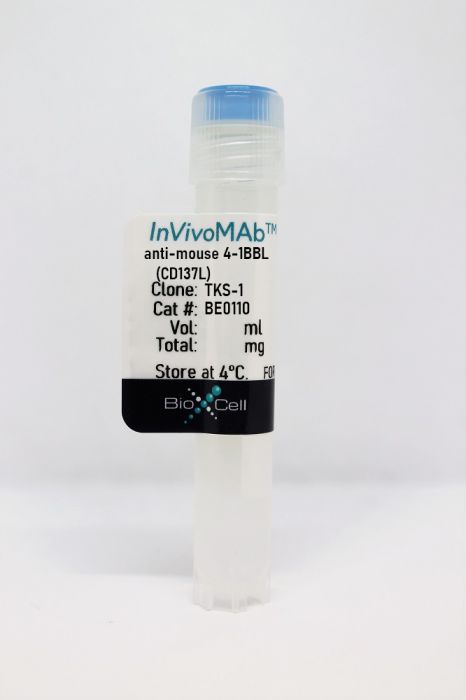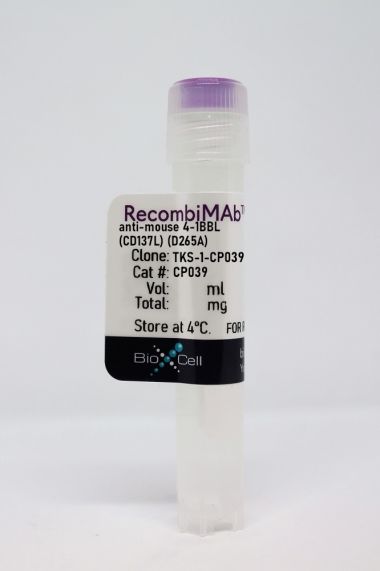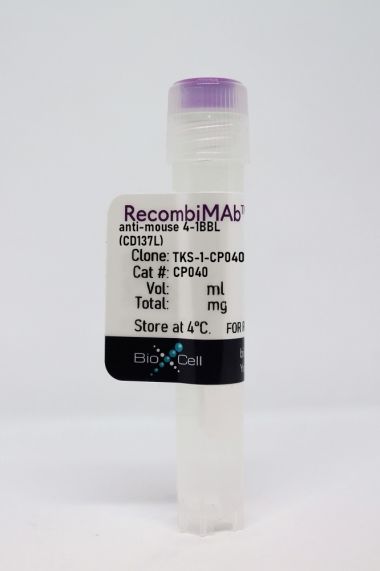InVivoMAb anti-mouse 4-1BBL (CD137L)
Product Details
The TKS-1 monoclonal antibody reacts with mouse 4-1BB ligand (4-1BBL), a type II transmembrane glycoprotein also known as CD137L. 4-1BBL is a 97 kDa member of the TNF superfamily and is expressed by dendritic cells, macrophages, and activated B and T lymphocytes. Interaction of 4-1BBL with 4-1BB (CD137) provides costimulatory signals to both CD4 and CD8 T cells through the activation of NF-κB, c-Jun and p38 downstream pathways. The TKS-1 antibody has been shown to inhibit the binding of soluble 4-1BB to 4-1BBL in vitro.Specifications
| Isotype | Rat IgG2a, κ |
|---|---|
| Recommended Isotype Control(s) | InVivoMAb rat IgG2a isotype control, anti-trinitrophenol |
| Recommended Dilution Buffer | InVivoPure pH 7.0 Dilution Buffer |
| Conjugation | This product is unconjugated. Conjugation is available via our Antibody Conjugation Services. |
| Immunogen | Mouse 4-1BBL transfected NRK cells |
| Reported Applications |
in vivo 4-1BBL blockade ELISA |
| Formulation |
PBS, pH 7.0 Contains no stabilizers or preservatives |
| Endotoxin |
<2EU/mg (<0.002EU/μg) Determined by LAL gel clotting assay |
| Purity |
>95% Determined by SDS-PAGE |
| Sterility | 0.2 µm filtration |
| Production | Purified from cell culture supernatant in an animal-free facility |
| Purification | Protein G |
| RRID | AB_10949069 |
| Molecular Weight | 150 kDa |
| Storage | The antibody solution should be stored at the stock concentration at 4°C. Do not freeze. |
Additional Formats
Recommended Products
ELISA
Thomas, S., et al. (2019). "Development of a new fusion-enhanced oncolytic immunotherapy platform based on herpes simplex virus type 1" J Immunother Cancer 7(1): 214. PubMed
Oncolytic viruses preferentially replicate in tumors as compared to normal tissue and promote immunogenic cell death and induction of host systemic anti-tumor immunity. HSV-1 was chosen for further development as an oncolytic immunotherapy in this study as it is highly lytic, infects human tumor cells broadly, kills mainly by necrosis and is a potent activator of both innate and adaptive immunity. HSV-1 also has a large capacity for the insertion of additional, potentially therapeutic, exogenous genes. Finally, HSV-1 has a proven safety and efficacy profile in patients with cancer, talimogene laherparepvec (T-VEC), an oncolytic HSV-1 which expresses GM-CSF, being the only oncolytic immunotherapy approach that has received FDA approval. As the clinical efficacy of oncolytic immunotherapy has been shown to be further enhanced by combination with immune checkpoint inhibitors, developing improved oncolytic platforms which can synergize with other existing immunotherapies is a high priority. In this study we sought to further optimize HSV-1 based oncolytic immunotherapy through multiple approaches to maximize: (i) the extent of tumor cell killing, augmenting the release of tumor antigens and danger-associated molecular pattern (DAMP) factors; (ii) the immunogenicity of tumor cell death; and (iii) the resulting systemic anti-tumor immune response.
in vivo 4-1BBL blockade
Welten, S. P., et al. (2015). "The viral context instructs the redundancy of costimulatory pathways in driving CD8(+) T cell expansion" Elife 4. doi : 10.7554/eLife.07486. PubMed
Signals delivered by costimulatory molecules are implicated in driving T cell expansion. The requirements for these signals, however, vary from dispensable to essential in different infections. We examined the underlying mechanisms of this differential T cell costimulation dependence and found that the viral context determined the dependence on CD28/B7-mediated costimulation for expansion of naive and memory CD8(+) T cells, indicating that the requirement for costimulatory signals is not imprinted. Notably, related to the high-level costimulatory molecule expression induced by lymphocytic choriomeningitis virus (LCMV), CD28/B7-mediated costimulation was dispensable for accumulation of LCMV-specific CD8(+) T cells because of redundancy with the costimulatory pathways induced by TNF receptor family members (i.e., CD27, OX40, and 4-1BB). Type I IFN signaling in viral-specific CD8(+) T cells is slightly redundant with costimulatory signals. These results highlight that pathogen-specific conditions differentially and uniquely dictate the utilization of costimulatory pathways allowing shaping of effector and memory antigen-specific CD8(+) T cell responses.
in vivo 4-1BBL blockade
Kurche, J. S., et al. (2010). "Comparison of OX40 ligand and CD70 in the promotion of CD4+ T cell responses" J Immunol 185(4): 2106-2115. PubMed
The TNF superfamily members CD70 and OX40 ligand (OX40L) were reported to be important for CD4(+) T cell expansion and differentiation. However, the relative contribution of these costimulatory signals in driving CD4(+) T cell responses has not been addressed. In this study, we found that OX40L is a more important determinant than CD70 of the primary CD4(+) T cell response to multiple immunization regimens. Despite the ability of a combined TLR and CD40 agonist (TLR/CD40) stimulus to provoke appreciable expression of CD70 and OX40L on CD8(+) dendritic cells, resulting CD4(+) T cell responses were substantially reduced by Ab blockade of OX40L and, to a lesser degree, CD70. In contrast, the CD8(+) T cell responses to combined TLR/CD40 immunization were exclusively dependent on CD70. These requirements for CD4(+) and CD8(+) T cell activation were not limited to the use of combined TLR/CD40 immunization, because vaccinia virus challenge elicited primarily OX40L-dependent CD4 responses and exclusively CD70-dependent CD8(+) T cell responses. Attenuation of CD4(+) T cell priming induced by OX40L blockade was independent of signaling through the IL-12R, but it was reduced further by coblockade of CD70. Thus, costimulation by CD70 or OX40L seems to be necessary for primary CD4(+) T cell responses to multiple forms of immunization, and each may make independent contributions to CD4(+) T cell priming.
- Cancer Research,
- Immunology and Microbiology
Macrophage STING signaling promotes NK cell to suppress colorectal cancer liver metastasis via 4-1BBL/4-1BB co-stimulation.
In Journal for Immunotherapy of Cancer on 1 March 2023 by Sun, Y., Hu, H., et al.
PubMed
Macrophage innate immune response plays an important role in tumorigenesis. However, the role and mechanism of macrophage STING signaling in modulating tumor microenvironment to suppress tumor growth at secondary sites remains largely unclear. STING expression was assessed in liver samples from patients with colorectal cancer (CRC) liver metastasis. Global or myeloid stimulator of interferon gene (STING)-deficient mice, myeloid NOD-like receptor protein 3 (NLRP3)-deficient mice, and wild-type (WT) mice were subjected to a mouse model of CRC liver metastasis by intrasplenic injection of murine colon carcinoma cells (MC38). Liver non-parenchymal cells including macrophages and natural killer (NK) cells were isolated for flow cytometry analysis. Bone marrow-derived macrophages pretreated with MC38 were co-cultured with splenic NK cells for in vitro studies. Significant activation of STING signaling were detected in adjacent and tumor tissues and intrahepatic macrophages. Global or myeloid STING-deficient mice had exacerbated CRC liver metastasis and shorten survival, with decreased intrahepatic infiltration and impaired antitumor function of NK cells. Depletion of NK cells in WT animals increased their metastatic burden, while no significant effects were observed in myeloid STING-deficient mice. STING activation contributed to the secretion of interleukin (IL)-18 and IL-1β by macrophages, which optimized antitumor activity of NK cells by promoting the expression of 4-1BBL in macrophages and 4-1BB in NK cells, respectively. Moreover, MC38 treatment activated macrophage NLRP3 signaling, which was inhibited by STING depletion. Myeloid NLRP3 deficiency increased tumor burden and suppressed activation of NK cells. NLRP3 activation by its agonist effectively suppressed CRC liver metastasis in myeloid SITNG-deficient mice. We demonstrated that STING signaling promoted NLRP3-mediated IL-18 and IL-1β production of macrophages to optimize the antitumor function of NK cells via the co-stimulation signaling of 4-1BBL/4-1BB. © Author(s) (or their employer(s)) 2023. Re-use permitted under CC BY-NC. No commercial re-use. See rights and permissions. Published by BMJ.
- Immunology and Microbiology
Activation of 4-1BBL+ B cells with CD40 agonism and IFNγ elicits potent immunity against glioblastoma.
In The Journal of Experimental Medicine on 4 January 2021 by Lee-Chang, C., Miska, J., et al.
PubMed
Immunotherapy has revolutionized the treatment of many tumors. However, most glioblastoma (GBM) patients have not, so far, benefited from such successes. With the goal of exploring ways to boost anti-GBM immunity, we developed a B cell-based vaccine (BVax) that consists of 4-1BBL+ B cells activated with CD40 agonism and IFNγ stimulation. BVax migrates to key secondary lymphoid organs and is proficient at antigen cross-presentation, which promotes both the survival and the functionality of CD8+ T cells. A combination of radiation, BVax, and PD-L1 blockade conferred tumor eradication in 80% of treated tumor-bearing animals. This treatment elicited immunological memory that prevented the growth of new tumors upon subsequent reinjection in cured mice. GBM patient-derived BVax was successful in activating autologous CD8+ T cells; these T cells showed a strong ability to kill autologous glioma cells. Our study provides an efficient alternative to current immunotherapeutic approaches that can be readily translated to the clinic. © 2020 Lee-Chang et al.
- In Vivo,
- Mus musculus (House mouse)
Agonist-induced 4-1BB activation prevents the development of Sjӧgren's syndrome-like sialadenitis in non-obese diabetic mice.
In Biochimica et Biophysica Acta. Molecular Basis of Disease on 1 March 2020 by Zhou, J., You, B. R., et al.
PubMed
Activation of costimulatory receptor 4-1BB enhances T helper 1 (Th1) and CD8 T cell responses in protective immunity, and prevents or attenuates several autoimmune diseases by increasing Treg numbers and suppressing Th17 or Th2 effector response. We undertook this study to elucidate the impact of enforced 4-1BB activation on the development of Sjögren's syndrome (SS)-like sialadenitis in non-obese diabetic (NOD) model of this disease. An anti-4-1BB agnostic antibody was intraperitoneally injected to female NOD mice aged 7 weeks, prior to the disease onset that occurs around 10-11 weeks of age, 3 times weekly for 2 weeks, and the mice were analyzed for SS pathologies at age 11 weeks. The salivary flow rate was markedly higher in the anti-4-1BB-treated NOD mice compared to the IgG-treated controls. Anti-4-1BB treatment significantly reduced the leukocyte infiltration of the submandibular glands (SMGs) and the levels of serum antinuclear antibodies. Flow cytometric analysis showed that the percentages of CD4 T cells, Th17 cells and plasmacytoid dendritic cells among SMG leukocytes were markedly reduced by anti-4-1BB treatment, in conjunction with a reduction in SMG IL-23p19 mRNA levels and serum IL-17 concentrations. Although the proportion of Tregs and IL-10 mRNA levels in SMGs were not altered by 4-1BB activation, IL-10 mRNA levels in salivary gland-draining lymph nodes and serum IL-10 concentrations were both markedly increased. While anti-4-1BB treatment did not affect the amount of Th1 cells and IFNγ mRNA in the SMGs, it increased these measurables in salivary gland-draining lymph nodes. Hence, agonistic activation of 4-1BB impedes the development of SS-like sialadenitis and hyposalivation. Copyright © 2019 Elsevier B.V. All rights reserved.
- Immunology and Microbiology
Development of a new fusion-enhanced oncolytic immunotherapy platform based on herpes simplex virus type 1.
In Journal for Immunotherapy of Cancer on 10 August 2019 by Thomas, S., Kuncheria, L., et al.
PubMed
Oncolytic viruses preferentially replicate in tumors as compared to normal tissue and promote immunogenic cell death and induction of host systemic anti-tumor immunity. HSV-1 was chosen for further development as an oncolytic immunotherapy in this study as it is highly lytic, infects human tumor cells broadly, kills mainly by necrosis and is a potent activator of both innate and adaptive immunity. HSV-1 also has a large capacity for the insertion of additional, potentially therapeutic, exogenous genes. Finally, HSV-1 has a proven safety and efficacy profile in patients with cancer, talimogene laherparepvec (T-VEC), an oncolytic HSV-1 which expresses GM-CSF, being the only oncolytic immunotherapy approach that has received FDA approval. As the clinical efficacy of oncolytic immunotherapy has been shown to be further enhanced by combination with immune checkpoint inhibitors, developing improved oncolytic platforms which can synergize with other existing immunotherapies is a high priority. In this study we sought to further optimize HSV-1 based oncolytic immunotherapy through multiple approaches to maximize: (i) the extent of tumor cell killing, augmenting the release of tumor antigens and danger-associated molecular pattern (DAMP) factors; (ii) the immunogenicity of tumor cell death; and (iii) the resulting systemic anti-tumor immune response. To sample the wide diversity amongst clinical strains of HSV-1, twenty nine new clinical strains isolated from cold sores from otherwise healthy volunteers were screened across a panel of human tumor cell lines to identify the strain with the most potent tumor cell killing ability, which was then used for further development. Following deletion of the genes encoding ICP34.5 and ICP47 to provide tumor selectivity, the extent of cell killing and the immunogenicity of cell death was enhanced through insertion of a gene encoding a truncated, constitutively highly fusogenic form of the envelope glycoprotein of gibbon ape leukemia virus (GALV-GP-R-). A number of further armed derivatives of this virus were then constructed intended to further enhance the anti-tumor immune response which was generated following fusion-enhanced, oncolytic virus replication-mediated cell death. These viruses expressed GMCSF, an anti-CTLA-4 antibody-like molecule, CD40L, OX40L and/or 4-1BB, each of which is expected to act predominantly at the site and time of immune response initiation. Expression of these proteins was confirmed by ELISA and/or western blotting. Immunogenic cell death was assessed by measuring the levels of HMGB1 and ATP from cell free supernatants from treated cells, and by measuring the surface expression of calreticulin. GALV-GP-R- mediated cell to cell fusion and killing was tested in a range of tumor cell lines in vitro. Finally, the in vivo therapeutic potential of these viruses was tested using human A549 (lung cancer) and MDA-MB-231(breast cancer) tumor nude mouse xenograft models and systemic anti-tumor effects tested using dual flank syngeneic 4434 (melanoma), A20 (lymphoma) mouse tumor models alone and in combination with a murine anti-PD1 antibody, and 9 L (gliosarcoma) tumors in rats. The twenty nine clinical strains of HSV-1 isolated and tested demonstrated a broad range of tumor cell killing abilities allowing the most potent strain to be identified which was then used for further development. Oncolytic ability was demonstrated to be further augmented by the expression of GALV-GP-R- in a range of tumor cell lines in vitro and in mouse xenograft models in nude mice. The expression of GALV-GP-R- was also demonstrated to lead to enhanced immunogenic cell death in vitro as confirmed by the increased release of HMGB1 and ATP and increased levels of calreticulin on the cell surface. Experiments using the rat 9 L syngeneic tumor model demonstrated that GALV-GP-R- expression increased abscopal uninjected (anenestic) tumor responses and data using mouse 4434 tumors demonstrated that virus treatment increased CD8+ T cell levels both in the injected and uninjected tumor, and also led to increased expression of PD-L1. A combination study using varying doses of a virus expressing GALV-GP-R- and mGM-CSF and an anti-murine PD1 antibody showed enhanced anti-tumor effects with the combination which was most evident at low virus doses, and also lead to immunological memory. Finally, treatment of mice with derivatives of this virus which additionally expressed anti-mCTLA-4, mCD40L, m4-1BBL, or mOX40L demonstrated enhanced activity, particularly in uninjected tumors. The new HSV-1 based platform described provides a potent and versatile approach to developing new oncolytic immunotherapies for clinical use. Each of the modifications employed was demonstrated to aid in optimizing the potential of the virus to both directly kill tumors and to lead to systemic therapeutic benefit. For clinical use, these viruses are expected to be most effective in combination with other anti-cancer agents, in particular PD1/L1-targeted immune checkpoint blockade. The first virus from this program (expressing GALV-GP-R- and hGM-CSF) has entered clinical development alone and in combination with anti-PD1 therapy in a number of tumor types (NCT03767348).









